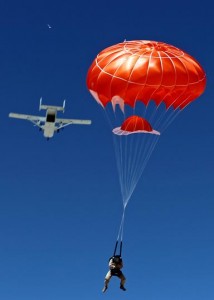
EDWARDS AFB – There’s a lot to be said by AC-130 gunship aircrew members who are proud of their heavily armed aircraft. These aircraft have the latest in sophisticated weapons, high tech sensors, navigation and fire control systems; however, it lacked one thing – a lightweight parachute that was agile enough for the entire crew to use.
Thanks to the work of the Aircrew Performance Branch Program Office, part of the Air Force Life Cycle Management Center’s Agile Combat Support Directorate, and testing completed in April by the Global Reach Combined Test Force Test Parachutist Program, crew members aboard AC-130s will now have a lightweight alternative, the Low Profile Parachute.

“The LPP program is success story for Air Force Materiel Command’s newly established five-center construct. The five centers, which report directly to AFMC, include Air Force Life Cycle Management Center, Air Force Test Center, Air Force Research Laboratory, Air Force Nuclear Weapons Center, and Air Force Sustainment Center,” said Lt. Col. Christopher Lemanski, AFLCMC Aircrew Performance Branch program manager. “The men and women of two of these centers, AFLCMC and AFTC, worked very closely to select and test a low-cost, commercially available emergency egress parachute suitable for the AC-130 community. Within AFLCMC, the Aircrew Performance Branch is responsible to the Air Force Program Executive Officer for Agile Combat Support for acquiring LPPs within cost, schedule and performance requirements and timelines.”
“Ultimately, AC-130 crew members needed a chute that was easy to walk around with while they executed their mission and they needed a parachute rig that was lighter and slimmer,” added Tech. Sgt. Joe Monreal, 418th FLTS NCOIC of Test Parachutist Program, who was also a test jumper during the test phase of the LPP. “After carefully going through the research, planning and selection phase in 2010, the LPP eventually proved to be the best alternative.”
According to Monreal, the LPP is intended to replace the BA-22 parachute which is currently configured for use in the AC-130 and weighs approximately 40 pounds, depending on the configuration.
“In addition to weighing nearly one-half of the BA-22, this new parachute will help save the Air Force money on the purchase price of emergency chutes and on the repacking cycle, but more importantly, it will help save lives of crew members that may find themselves in an egress situation,” added Monreal.
With the execution phase beginning in early February 2012, the team of test jumpers, flight test engineers, human factors engineers, rigger support specialists and drop zone safety officers, all said that to get to the completion phase, extensive training had to be completed before any of the test jumpers could don the LPPs.

“Before we could perform actual jumps, we first had to accomplish wind tunnel training in Perris, Calif., with the parachutes,” Monreal said. “After this, we outfitted dummies with the LPPs and used a World War II B-25 Bomber and SC.7 Skyvan to drop them out of the bomb bay. Soon after this, we began staging out of the California City airport in order to execute live drops at the Edwards Farm Drop Zone.”
During the duration of the test, the team flew approximately 55 sorties with challenges along the way, according to Monreal.
“Some minor malfunctions, such as line twists, were experienced, not to mention some hard openings at high speeds and some hard landings, so you can say we all definitely earned our pay,” said Monreal. “But, in the end, we all feel that this new system will help AC-130 aircrew members across the Air Force accomplish the mission more effectively and safely.”
–